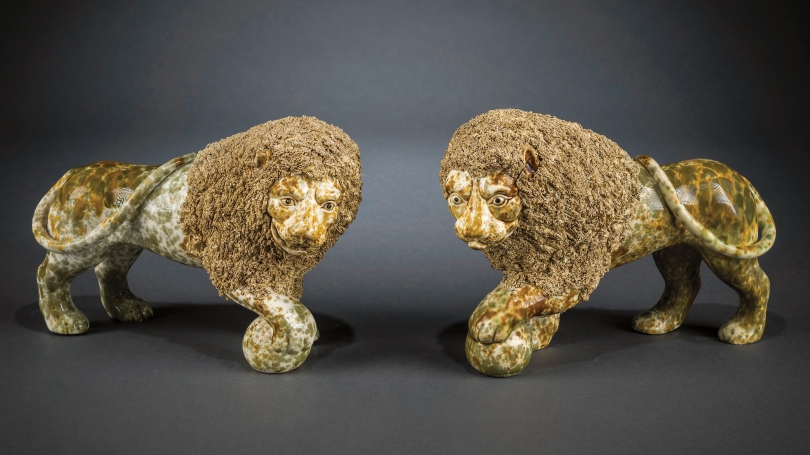Hood Quarterly, spring/summer 2016
Like many other trades, pottery production in nineteenth-century America shifted from small shops reliant on hand craftsmanship to larger operations that utilized new techniques to reach expanded, more dispersed markets. By the mid-nineteenth century, Bennington, Vermont—long a center for the production of ceramics—had become one of the foremost pottery producers nationally. In 1848, the succession of Bennington’s Norton and Fenton family industries became Lyman, Fenton & Company, and in 1853, reincorporated as the United States Pottery Company. The latter two firms gained renown for their affordable utilitarian wares and press-molded figural sculptures intended for average, middle-class homes.
Among the company’s most popular pieces were ornamental animals that, when produced in pairs like these standing lions, served as ideal adornments for a parlor fireplace mantel. These particular lions are notable not only for their textured “coleslaw” manes made of shredded clay, but also for their light green and amber coloration, which is rarer than the firm’s mottled brown glazes and exemplifies the lively, multihued surfaces that the firm marketed as “flint enamel.”
The lions’ basic form, with one paw resting on a globe—a gesture evoking dominion—derived from popular English models made in Staffordshire. These, in turn, were based on the famed Medici lions in Florence, one dating in part to the second century CE (it was reworked during the Renaissance) and the other to the late sixteenth century. The Bennington examples, therefore, reflect the enduring influence of neoclassicism in mid-nineteenth-century American decor. One can only surmise whether, in their day, these engaging figurines sparked any of the age-old associations of lions with kingship, power, sovereignty, and protection. It seems unlikely that in a then–relatively young democracy the original owners would have embraced a link with monarchy, but who could deny the appeal of a pair of watchful sentinels enlivening and guarding the household?
